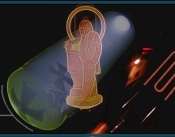More precisely this kind of tubes or valves are called "Tungar" because the fact of its operating principle.
These are constituted by a tungsten filament inside a glass globe, in front wich there is a graphite plate. The globe is filled with pure argon at a low pressure. When the filament is heated by an external current, it glows and emits electrons that are attracted by the graphite plate only when this is positive respect to the filament. In such a way, the filament acts as the cathode and the plate as the anode of the tube, being increased the pass of current by the argon ionization phenomenon. This made this tube useful for low voltage rectifying allowing i.e. battery charging.
As Chris said, to get a higher performance, two tubes must be used simultaneously in full-wave mode by means of a center-tapped secondary in the input transformer. So, the resulting DC are smoother than if one only tube were used, being possible to use cheaper filter elements.
The word TUNGAR comes from TUNGsten and ARgon, making reference to both main elements used in it.
Another use for Tungar tubes were as rectifiers for low intensity voltaic arcs in movie projection lanterns in a time in wich the copper clad carbon rods for high intensity arcs were not common yet, and of course much before the advent of high intensity xenon arc lamps today in use for cinema projection.
For this uses (movie arcs), the most common choice was the polyphase mercury pool rectifiers, followed by the "dry" and "solid" selenium plate rectifiers. Xenon lamps came more or less when the silicon diodes appeared in scene, so, these ones are the only one used today, not only for cinema, but for all purpuse rectifying systems, no matter what power are used in which, from milliwatts to megawatts silicon diodes are present whatever one looks, leaving obsolette such a nice things like these Tungar valve.
Regards.











